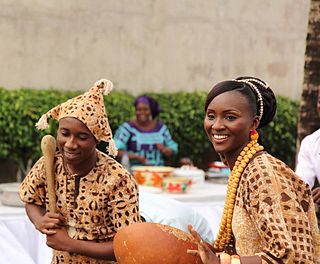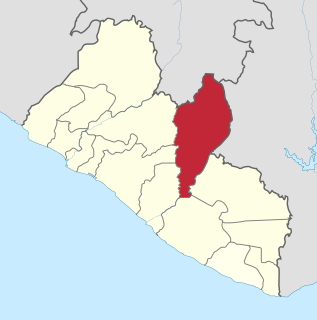Related Research Articles

Ivory Coast, also known as Côte d'Ivoire, officially the Republic of Côte d'Ivoire, is a country on the southern coast of West Africa. Its capital is Yamoussoukro, in the centre of the country, while its largest city and economic centre is the port city of Abidjan. It borders Guinea to the northwest, Liberia to the west, Mali to the northwest, Burkina Faso to the northeast, Ghana to the east, and the Gulf of Guinea to the south. Its official language is French, and indigenous languages are also widely used, including Bété, Baoulé, Dioula, Dan, Anyin, and Cebaara Senufo. In total, there are around 78 different languages spoken in Ivory Coast. The country has a religiously diverse population, including numerous followers of Christianity, Islam, and indigenous faiths.

The Senufo people, also known as Siena, Senefo, Sene, Senoufo, and Syénambélé, are a West African ethnolinguistic group. They consist of diverse subgroups living in a region spanning the northern Ivory Coast, the southeastern Mali and the western Burkina Faso. One sub-group, the Nafana, is found in north-western Ghana.

Félix Houphouët-Boigny, affectionately called Papa Houphouët or Le Vieux, was the first president of Ivory Coast, serving from 1960 until his death in 1993. A tribal chief, he worked as a medical aide, union leader and planter before being elected to the French Parliament. He served in several ministerial positions within the French government before leading Côte d'Ivoire following independence in 1960. Throughout his life, he played a significant role in politics and the decolonization of Africa.

The Baule or Baoulé are an Akan people and one of the largest ethnicities in Côte d'Ivoire who historically migrated from what is today Ghana. The Baoulé are traditionally farmers who live in the centre of Côte d'Ivoire, in a triangle shaped region between the rivers Bandama and N'Zi. This area broadly encompasses the regions around the cities of Bouaké and Yamoussoukro. The Baoulé have come to play a relatively important role in the recent history of Côte d'Ivoire: the State's first President, Félix Houphouët-Boigny, was a Baoulé; additionally, since the Ivorian cocoa boom of the 1960-1970s, the Baoulé have also become one of the most widespread ethnicity throughout the country, especially in the Southern forests where they are amongst the most numerous planters of cocoa, rubber, and coffee and sometimes seem to outnumber the local native ethnic groups.

Nimba County is a county in northeastern Liberia that shares borders with the Republic of Côte d'Ivoire in the East and the Republic of Guinea in the Northwest. Its capital city is Sanniquellie and its most populous city is Ganta. With the county's area measuring 11,551 square kilometres (4,460 sq mi), Nimba is the largest of Liberia's 15 counties. The county has six statutory districts. As of the 2008 Census, it had a population of 462,026, making it the second most-populous county in Liberia.

Egusi is the name for the protein-rich seeds of certain cucurbitaceous plants, which after being dried and ground are used as a major ingredient in West African cuisine.

Ivory Coast and Ghana, together produce nearly 60% of the world's cocoa each year. During the 2018/19 cocoa-growing season, research commissioned by the U.S Department of Labor was conducted by NORC at the University of Chicago in these two countries and found that 1.48 million children are engaged in hazardous work on cocoa farms including working with sharp tools and agricultural chemicals and carrying heavy loads. That number of children is significant, representing 43 percent of all children living in agricultural households in cocoa growing areas. During the same period cocoa production in Cote d’Ivoire and Ghana increased 62 percent while the prevalence of child labour in cocoa production among all agricultural households increased 14 percentage points. Attention on this subject has focused on West Africa, which collectively supplies 69% of the world's cocoa, and Côte d'Ivoire, supplying 35%, in particular. The 2016 Global Estimates of Child Labour indicate that one-fifth of all African children are involved in child labour. Nine percent of African children are in hazardous work. It is estimated that more than 1.8 million children in West Africa are involved in growing cocoa. A 2013–14 survey commissioned by the Department of Labor and conducted by Tulane University found that an estimated 1.4 million children aged 5 years old to 11 years old worked in agriculture in cocoa-growing areas, while approximately 800,000 of them were engaged in hazardous work, including working with sharp tools and agricultural chemicals and carrying heavy loads. According to the NORC study, methodological differences between the 2018/9 survey and earlier ones, together with errors in the administration of the 2013/4 survey have made it challenging to document changes in the number of children engaged in child labour over the past five years.
Articles related to Senegal include:

The Tchaman or Ébrié are an Akan people living in the Abidjan region of Côte d'Ivoire. Originally called the "Tchaman/Kyama/Gyama" or "Achan", the name Ébrié was given to them by the neighboring Abouré people. In the Abouré language, Ébrié means "bad" and was given to them after a military defeat. In turn, however, they refer to the Abouré as "Koroman," which means "dirty people" in the Tchaman, Kyaman, or Gyaman (Achan) language. The traditional lands of the Tchaman/Kyaman/Gyaman lie along the Ébrié Lagoon, which extends from Grand-Bassam to Assagni and includes the city of Abidjan and its environs. The Tchaman make up approximately 0.7% of the population of Côte d'Ivoire.

Women in Ivory Coast formed less than half the country's population in 2003. Their social roles and opportunities have changed since the time of French colonialism.
The Loron people, variously named Lorhon, Tenbo, Teguessie and Thuuna, who are located in the forested savannah region of northeast Côte d’Ivoire and southwest Burkina Faso, came originally from the Bouna region of Côte d’Ivoire. There are approximately 10,000 Loron people. Their language, which is called Téén, is 45% cognate with that of the Kulango language in the Bouna area, although their culture reflects that of the Lobi people.

The economy of Ivory Coast is stable and currently growing, in the aftermath of political instability in recent decades. The Ivory Coast's economy is largely market-based and depends heavily on the agricultural sector. Almost 70% of the Ivorian people are engaged in some form of agricultural activity. GDP per capita grew 82% in the 1960s, reaching a peak growth of 360% in the 1970s, but this proved unsustainable and it shrank by 28% in the 1980s and a further 22% in the 1990s. This decline, coupled with high population growth, resulted in a steady fall in living standards. The Gross national product per capita, now rising again, was about US$727 in 1996. It was substantially higher two decades before.

Abidjan is the economic capital of the Ivory Coast. According to the 2021 census, Abidjan's population was 6.3 million, which is 21.5 percent of the overall population of the country, and this also makes it the sixth most populous city proper in Africa, after Lagos, Cairo, Kinshasa, Dar es Salaam, and Johannesburg. A cultural crossroads of West Africa, Abidjan is characterised by a high level of industrialisation and urbanisation. It also is one of the most populous French-speaking cities in Africa.
Ejigbo is a prominent town in Yoruba Land and the headquarters of Ejigbo Local Government Area, one of the oldest local government areas of Osun State in Nigeria. Ejigbo is strategically placed in the middle of the region, as 35 kilometres (22 mi) north-east of Iwo, 30 km (19 mi) from Ogbomoso in the north and 24 km (15 mi) from Ede in the south-east. It is about 40 km (25 mi) north-west of Osogbo, the capital of Osun State, and about 95 km (59 mi) north-east of Ibadan. It is part of the Ede North/Ede South/Egbedore/Ejigbo federal constituency. The population is 138,357 according to the GeoNames geographical database. The average elevation is 426 metres (1,398 ft).
There is a large population of Lebanese people in Côte d'Ivoire, whose numbers are variously estimated in the tens or hundreds of thousands. They are the largest Lebanese diaspora community in West Africa. An estimated 1% of all people living in the Ivory Coast are from Lebanon. 90% of the Lebanese community in Ivory Coast lives in Abidjan, where they represent over 7% of the total population.
Ivoirians in the United Kingdom or Ivorian British are one of the country's smallest African immigrant groups, consisting of no more than 10,000 individuals. The group includes people born in Côte d'Ivoire who have migrated to the United Kingdom, as well as their British-born descendants.
Ivorian Americans are an ethnic group of Americans of Ivorian descent. According to estimates, in 2014 there were 6,000 people in the United States of Ivorian ancestry.

Ivorian cuisine is the traditional cuisine of Côte d'Ivoire, or the Ivory Coast, and is based on tubers, grains, pig, chicken, seafood, fish, fresh fruits, vegetables and spices. It is very similar to that of neighboring countries in West Africa. Common staple foods include grains and tubers. Côte d'Ivoire is one of the largest cocoa producers in the world and also produces palm oil and coffee.
Prostitution in Ivory Coast is legal, but associated activities, such as soliciting, pandering or running brothels, are illegal. Sex workers report law enforcement is sparse and corrupt. Police sometimes harass sex workers and demand bribes or sexual favours. Transgender prostitutes are often targeted by police and soldiers and subjected to violence. It was estimated in 2014 that there were 9,211 prostitutes in the country.

Crime in Cote d'Ivoire is prevalent and versatile across the West African country. The most common forms of crime include child labour, arms trafficking, terrorism and human rights abuse. Other less common, but still evident types of crime include cannabis and synthetic drug trade, sex trafficking, fauna and flora crimes.
References
- ↑ Olson, James Stuart (1996). The peoples of Africa: an ethnohistorical dictionary. Santa Barbara, CA: Greenwood Press. p. 18. ISBN 978-0-313-27918-8.
- 1 2 3 Asiculture.com. "Avikam, Brignan Ethnic Group in Côte d'Ivoire (IV) | Africa Group". Avikam, Brignan Ethnic Group in Côte d'Ivoire (IV) | Africa Group. Retrieved 12 September 2022.